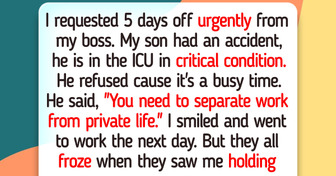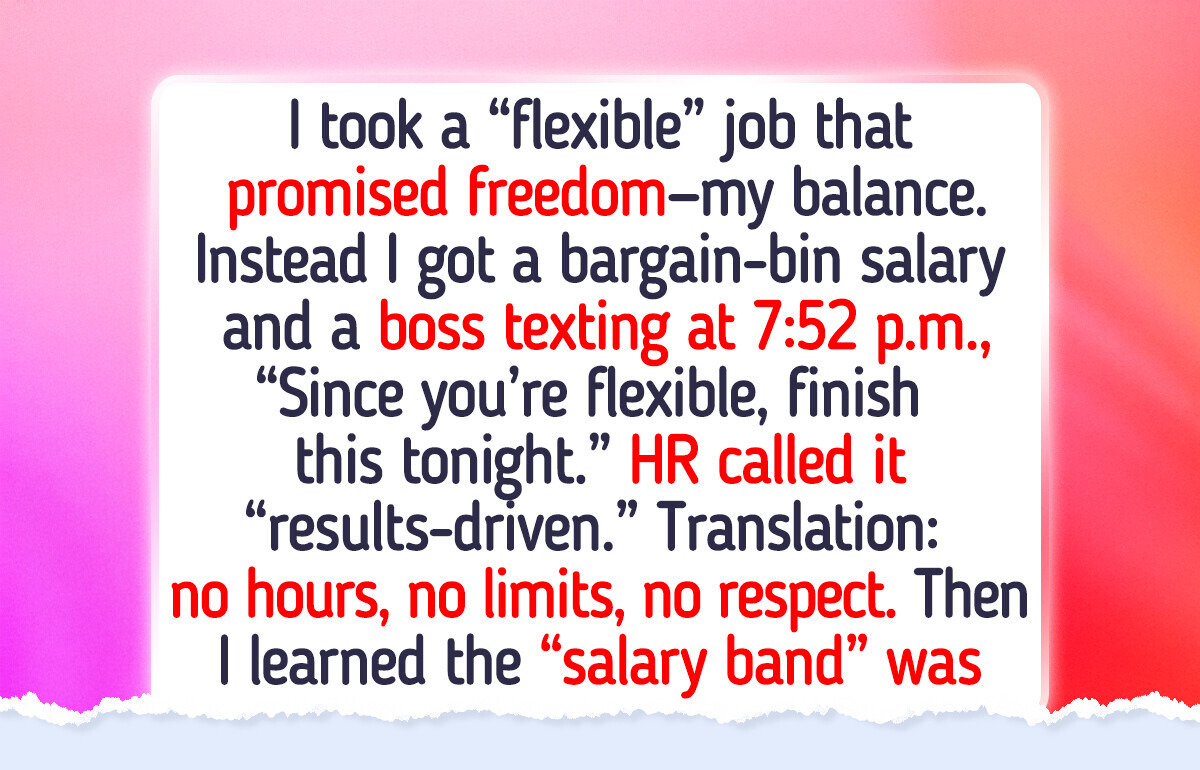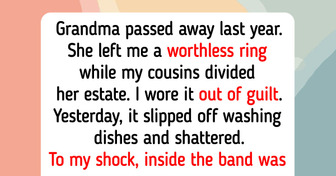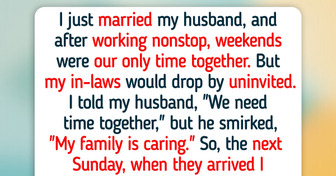I Refused to Go to Work After a Family Emergency—HR Got Involved


We received a letter from a reader who learned the hard way that a “flexible” job isn’t always what it seems. What she expected to be a balanced, supportive role turned into a draining experience with low pay and no respect. She asked us to share her story.

Hi Bright Side!
When I accepted the offer for a “flexible job,” I thought I’d finally escaped the toxic grind of my old workplace. The hiring manager promised freedom: choose my hours, manage my workload, work-life balance “built into the culture.” What I actually got was a salary so low it should’ve come with a warning label — and a job that treated my time like an all-you-can-eat buffet.
In my first week, my boss messaged me at 7:52 p.m., “Hey, since you’re flexible, can you just finish this tonight?”
The next morning, HR chirped, “We’re a results-driven team! You can work whenever... as long as deadlines are met.”
Translation: no schedule, no limits, and no respect.
My coworkers? Zombies. Burned out, over-caffeinated, and whispering “just wait until Q4” like it was a curse. Everyone was “flexible,” but somehow always online. Lunch breaks were a myth. PTO was a joke. Saturdays became “overflow days.”
When I finally pushed back and said, “I can’t work after 6,” my boss acted like I’d personally sabotaged the entire company. She said, “We hired you because you’re adaptable.”
But apparently “adaptable” meant “always available, never compensated.”
Then came the kicker:
I found out the “salary band” they claimed was fixed... wasn’t fixed at all. A new hire with less experience was making 20% more — because she said no to every unpaid task from day one.
That’s when it hit me:
The job wasn’t flexible. The boundaries were. Mine. Not theirs.
So I stopped being available 24/7. I stopped answering “quick questions” during dinner. I stopped accepting calendar invites outside my work hours. And within two weeks, everyone acted like I’d committed treason.
My boss pulled me into a meeting and said, “Your attitude has changed.”
I said, “No — my boundaries have.”
She didn’t like that answer.
But here’s the controversial truth no one admits:
Companies love “flexibility” because it means they can stretch you until you snap — and then blame you for breaking.
So I updated my résumé and sent out applications with one filter: remote, yes; flexible, absolutely not.
Because if a job needs flexibility, they’re not talking about the schedule.
They’re talking about you.
We’re grateful to our reader for writing in and shedding light on what really happens when HR policies and flexible work promises collide. Their experience is a reminder that standing up for fairness isn’t just brave — it’s necessary for building better, more honest workplaces.

Not so long ago, work had clear edges. You finished your tasks, walked away, and the rest of the day belonged to you. Even demanding jobs came with a point where you could finally breathe.
But that boundary has slowly disappeared.
The modern workday seems to stretch like elastic — pulling earlier into the morning and spilling later into the night. It interrupts meals, slips into weekends, and tags along on trips we’re supposed to enjoy. What used to be a simple 9-to-5 has quietly transformed into something much longer, with “just one more task” waiting around every corner.
We’ve dressed it up as flexibility, but somewhere along the line, flexible started sounding a lot like always on.
An “avoid sending emails after 6 p.m.” reminder won’t repair a culture that keeps people permanently switched on.
This problem isn’t about schedules — it’s about expectations, norms, and behavior.
Culture created it; only culture can fix it.
Here’s how to begin reshaping it:
1. Treat Time as Something Employees Own — Not Something the Company Controls
Empower teams to decide how they work best and to protect that space.
Set shared collaboration windows and make it clear that flexibility should never be interpreted as 24/7 access.
Help teams think through questions like:
When do we truly need immediate replies?
When should deep focus be protected at all costs?
When are people fully offline — without guilt or consequences?
2. Cut the Unnecessary Noise
Examine where disruption is actually coming from.
Are routine meetings eating up entire afternoons?
Are “quick updates” turning into another Zoom marathon?
Is poor planning creating last-minute fire drills?
You don’t need fewer meetings — you need purposeful ones.
Reduce the clutter so people can actually concentrate.
3. Set the Example, Not Just the Policy
Your behavior becomes the team’s baseline.
If you’re still sending messages at midnight, no guideline will convince your employees they can disconnect.
Use scheduled send.
Block off focus hours — and stick to them.
Make your downtime visible.
People don’t need you to say, “It’s okay to rest.”
They need to see that it’s normal.
4. Watch for the Early Warning Signs
Always-on culture doesn’t arrive loudly — it slides in quietly.
You’ll notice it in falling engagement, comments about constant interruptions, or a spike in after-hours activity.
Build check-ins and listening channels into your routine.
When something feels off, call it out early.
Employees aren’t looking for perfection — they’re looking for awareness and action.
Somewhere between “working from anywhere” and “always being online,” we forgot how to rest.
12 Stories That Prove Little Acts of Kindness Never Stay Little











